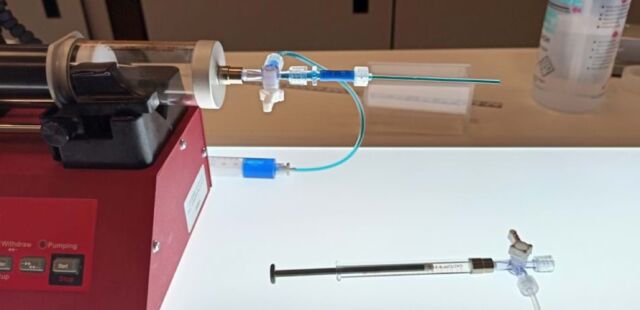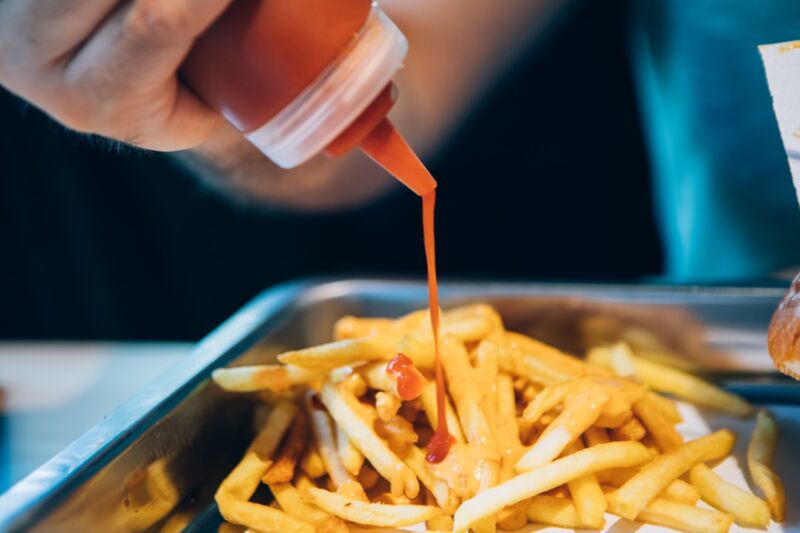Ketchup is one of the most popular condiments in the US, along with mayonnaise, but getting those few last dollops out of the bottle often results in a sudden splattering. "It's annoying, potentially embarrassing, and can ruin clothes, but can we do anything about it?" Callum Cuttle of the University of Oxford said during a press conference earlier this week at an American Physical Society meeting on fluid dynamics in Indianapolis, Indiana. "And more importantly, can understanding this phenomenon help us with any other problems in life?"
The answer to both questions, per Cuttle, is a resounding yes. Along with his Oxford colleague, Chris MacMinn, he conducted a series of experiments to identify the forces at play and develop a theoretical model for ketchup splatter. Among the most interesting findings: squeezing the bottle more slowly and doubling the diameter of the nozzle helps prevent splatter. There is also a critical threshold where the flow of ketchup shifts suddenly from not splattering to splattering. A preprint paper has been posted to arXiv and is currently undergoing peer review.
Isaac Newton identified the properties of what he deemed an "ideal liquid." One of those properties is viscosity, loosely defined as how much friction/resistance there is to flow in a given substance. The friction arises because a flowing liquid is essentially a series of layers sliding past one another. The faster one layer slides over another, the more resistance there is, and the slower one layer slides over another, the less resistance there is.
But not all liquids behave like Newton's ideal liquid. In Newton's ideal fluid, the viscosity is largely dependent on temperature and pressure: water will continue to flow — i.e., act like water — regardless of other forces acting upon it, such as being stirred or mixed. In a non-Newtonian fluid, the viscosity changes in response to an applied strain or shearing force, thereby straddling the boundary between liquid and solid behavior. Physicists like to call this a "shearing force": stirring a cup of water produces a shearing force, and the water shears to move out of the way. The viscosity remains unchanged. But the viscosity of non-Newtonian fluids changes when a shearing force is applied.
Ketchup is a non-Newtonian fluid. Blood, yogurt, gravy, mud, pudding, and thickened pie fillings are other examples, along with hagfish slime. They aren't all exactly alike in terms of their behavior, but none of them adhere to Newton's definition of an ideal liquid.

Ketchup, for instance, is comprised of pulverized tomato solids suspended in liquid, making it more of a "soft solid" rather than a liquid, according to Anthony Strickland of the University of Melbourne in Australia. The solids connect to create a continuous network, and one must overcome the strength of that network in order to get the ketchup to flow—typically by tapping or whacking the bottle. Once that happens, the viscosity decreases, and the more it decreases, the faster the ketchup flows. Scientists at Heinz have pegged the optimal flow rate or ketchup at 0.0045 per hour.
When there's only a little ketchup left in the bottle, you need to whack it that much harder, thereby increasing the risk of splatter. "By the time you get to the end, much of what's inside is air," said Cuttle. "So when you squeeze, what you're doing is compressing air inside the bottle, which build up pressure that drags the [ketchup] out." The nozzle provides a viscous drag force that counters the viscous flow of the ketchup, and the balance between them determines the flow rate. As the bottle empties, the viscosity decreases because there is less and less ketchup to push. And the outflow of liquid means there is more and more room for the air to expand inside the bottle, decreasing the driving force over time.
Understanding the complicated dynamics of why the smooth flow suddenly shifts to a splatter started with simplifying the problem. Cuttle and MacMinn created an analog of a ketchup bottle, filling syringes (basically capillary tubes) with ketchup and then injecting different amounts of air (from 0 to four milliliters) at fixed compression rates to see how changing the amount of air impacted the flow rate and whether the ketchup splattered. They repeated the experiments with syringes filled with silicon oil in order to better control the viscosity and other key variables.

The result: the syringes with 1 milliliter or more of air injected produced splatter. "This tells us that you need some air in the syringe or bottle to generate a splatter and create that unsteady burst of flow," said Cuttle. That constitutes a "sauce splatter" critical threshold where the ketchup shifts from smooth flow to splatter, depending on such factors as the amount of air, the rate of compression, and the diameter of the nozzle. Below that threshold, the driving force and liquid outflow are balanced, so the flow is smooth. Above the threshold, the driving force decreases faster than the outflow. The air becomes over-compressed, like a pent-up spring, and the last bit of ketchup is forced out in a sudden burst.
"The splattering of a ketchup bottle can come down to the finest of margins: squeezing even slightly too hard will produce a splatter rather than a steady stream of liquid," said Cuttle. One handy tip is to squeeze more slowly, thereby reducing the rate at which the air is compressed. Widening the diameter of the nozzle would help even more, since the rubber valve at the spout can exacerbate the risk of splatter. Granted, the valves help avoid leads, but they also force you to build up a certain amount of pressure to get the ketchup to start flowing form the bottle. Cuttle recommends just taking the cap off the bottle when it's nearly empty as a practical hack, squeezing the last bits of ketchup out of the broader neck.
"It's common sense, but now there's a rigorous mathematical framework to back it up," said Cuttle. "And a gas pushing a liquid out of the way is something that happens in a lot of other contexts." That includes aquifers for storing captured carbon dioxide, certain types of volcanic eruptions, and re-inflating collapsed lungs.
DOI: arXiv, 2022. 10.48550/arXiv.2112.12898 (About DOIs).



3175x175(CURRENT).thumb.jpg.b05acc060982b36f5891ba728e6d953c.jpg)

Recommended Comments
There are no comments to display.
Join the conversation
You can post now and register later. If you have an account, sign in now to post with your account.
Note: Your post will require moderator approval before it will be visible.